The number of blockchains is rapidly increasing, with 300 existing chains and 88 upcoming rollups, creating a need for cross-chain messaging protocols.
LayerZero supports the most blockchains (97 in total) and is expanding its support for new L1 and L2 networks, as well as various virtual machines (VMs).
LayerZero provides its infra to three customers - blockchains, dapp, and token projects.
The OApp standard by LayerZero enables developers to create custom cross-chain applications, as demonstrated by projects like Aragon's gasless voting system and DeFi Kingdom's asset bridge. Also, LayerZero's OFT standard is gaining traction, with major projects like WBTC, APE, and PYUSD adopting it.
Whether the cross-chain protocols will see growth in near future is yet to be seen, and the success will depend on not the number of blockchains, but the number of successful dapps.
The number of blockchains now stands at 300, with new L1 and L2 networks emerging at a rapid pace. As the hurdle to launching new blockchains and rollups continues to get lower, there are now 88 upcoming rollups set to launch soon. This fragmentation has created a need for messaging protocols to access other blockchains in a secure way. The process of cross-chain messaging can be broken down into three steps:
Transportation: The intermediaries, facilitate delivery between two blockchain networks.
Verification: Mechanisms to ensure the authenticity and integrity of cross-chain messages.
Execution: Systems that process and implement the instructions carried by these messages on the destination chain.
There have been multiple protocols acting as the backbone of this fragmented landscape. As the infrastructure is getting mature, the cross-chain messaging infrastructure should move to the background. Developers should focus on building application logic rather than worrying about the intricacies of cross-chain communication (Although understanding trust assumption is important). These solutions are evolving to become the invisible yet indispensable backbone.
LayerZero, one of the leading cross-chain messaging protocols, is becoming invisible to daily users, but actively expanding. In the past month, LayerZero has made progress in connecting blockchains. They've announced support for 11 new blockchains, including emerging Layer 2 solutions like Unichain, Apechain, Abstract, and Movement, as well as Layer 1 networks such as Initia and Sonic. LayerZero has also expanded its support for various decentralized applications, notably DeFi Kingdom with its OApp, and token projects like PYUSD, APE and WBTC using the OFT standard.
LayerZero's recent expansion to support multiple new blockchains offers insights into the strategic importance of cross-chain messaging. Before looking into the strategies, let’s look into the status of adoption in the overall messaging protocols.
Messaging protocol is difficult to build, as it requires nodes for every blockchain, and monitoring infra. Also to make it decentralized and customizable, it require additional infrastructure. Some of the major ones include LayerZero, Wormhole, Axelar, and Hyperlane. Other messaging protocols excluded include Chainlink CCIP, Celer IM, Zetachain. I excluded these in below comparison as these have limited adoption.
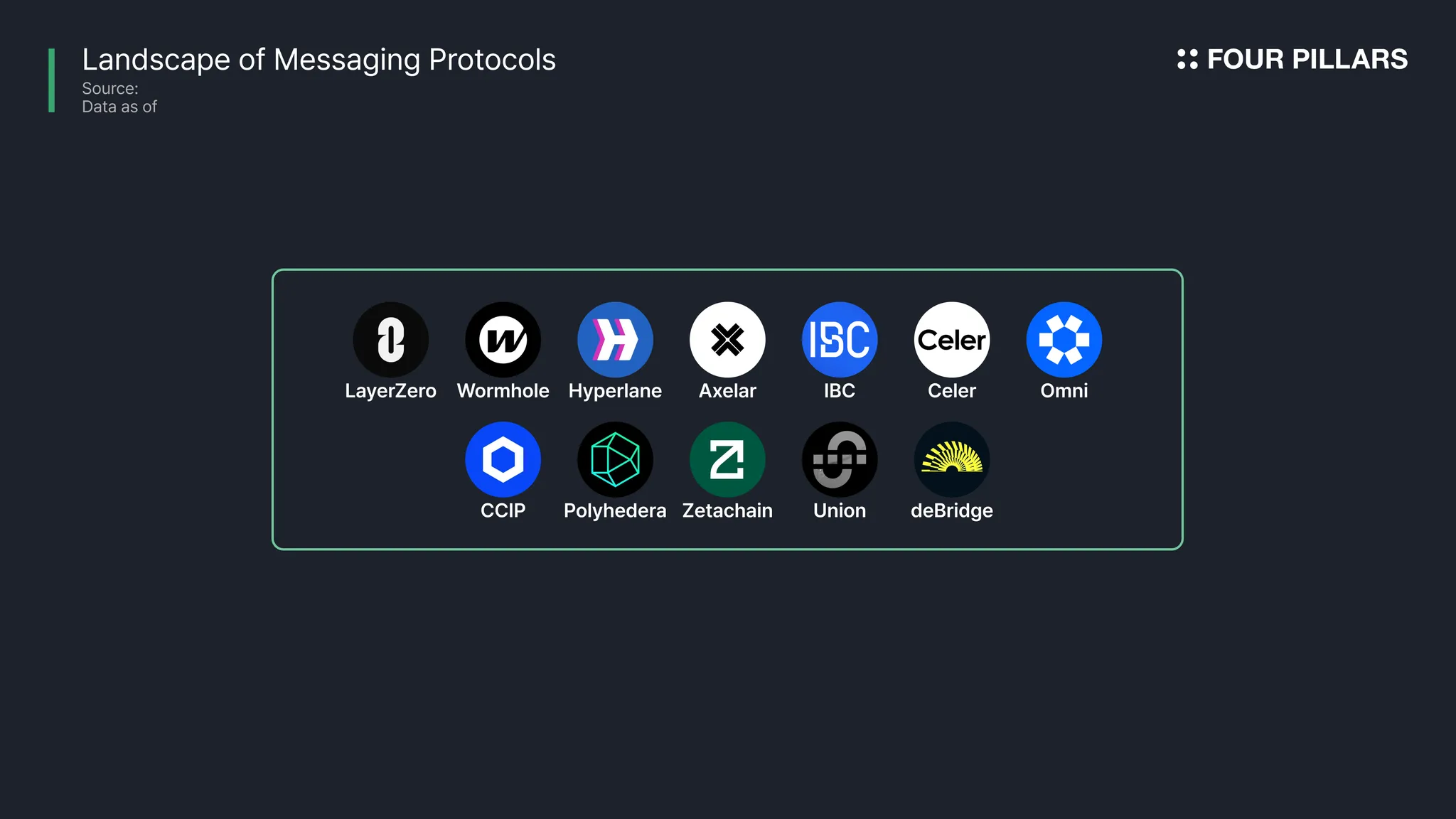
LayerZero currently supports the most blockchains, with 97 in total. Other protocols like Axelar and Hyperlane are also expanding their support. To increase support, messaging protocols should focus on two trends: the growing (i) number of rollups and (ii) types of virtual machines (VMs).
Among these messaging protocols, Wormhole has limited rollup support, compatible only with Arbitrum, Base, Optimism, and Polygon. On the other hand, Hyperlane and LayerZero are leading in supporting new rollups. Axelar initially faced tokenomics issues, resulting in higher inflation for new integrations. However, these issues have been addressed, and with the launch of Axelar Amplifier, integration is set to accelerate.
Additionally, messaging protocols are working on supporting various virtual machines (VMs), including EVM, SVM, MoveVM, CairoVM, and CosmWasm.
The success of supporting new blockchains and rollups will depend on how quickly and cost-effectively they can be deployed, as well as how easily they can be integrated into new VMs.
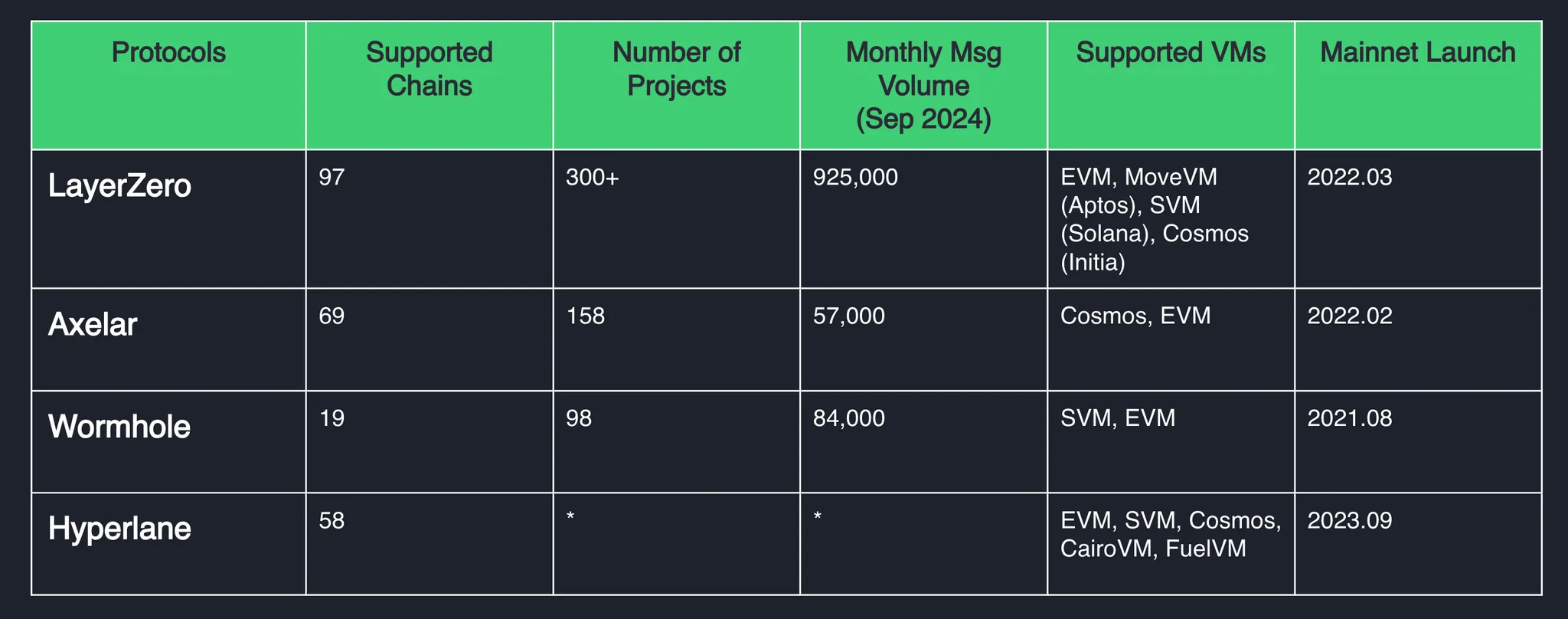
Source: Animoca Research on LayerZero Deep-Dive Part 1
According to data compiled by Animoca Research, LayerZero has the highest share of messaging volume, excluding IBC in the Cosmos ecosystem. An interesting trend observed is that new messaging protocols are also gaining market share. Additionally, as the number of blockchains increases, will this drive overall messaging volumes? This is an aspect people should investigate.
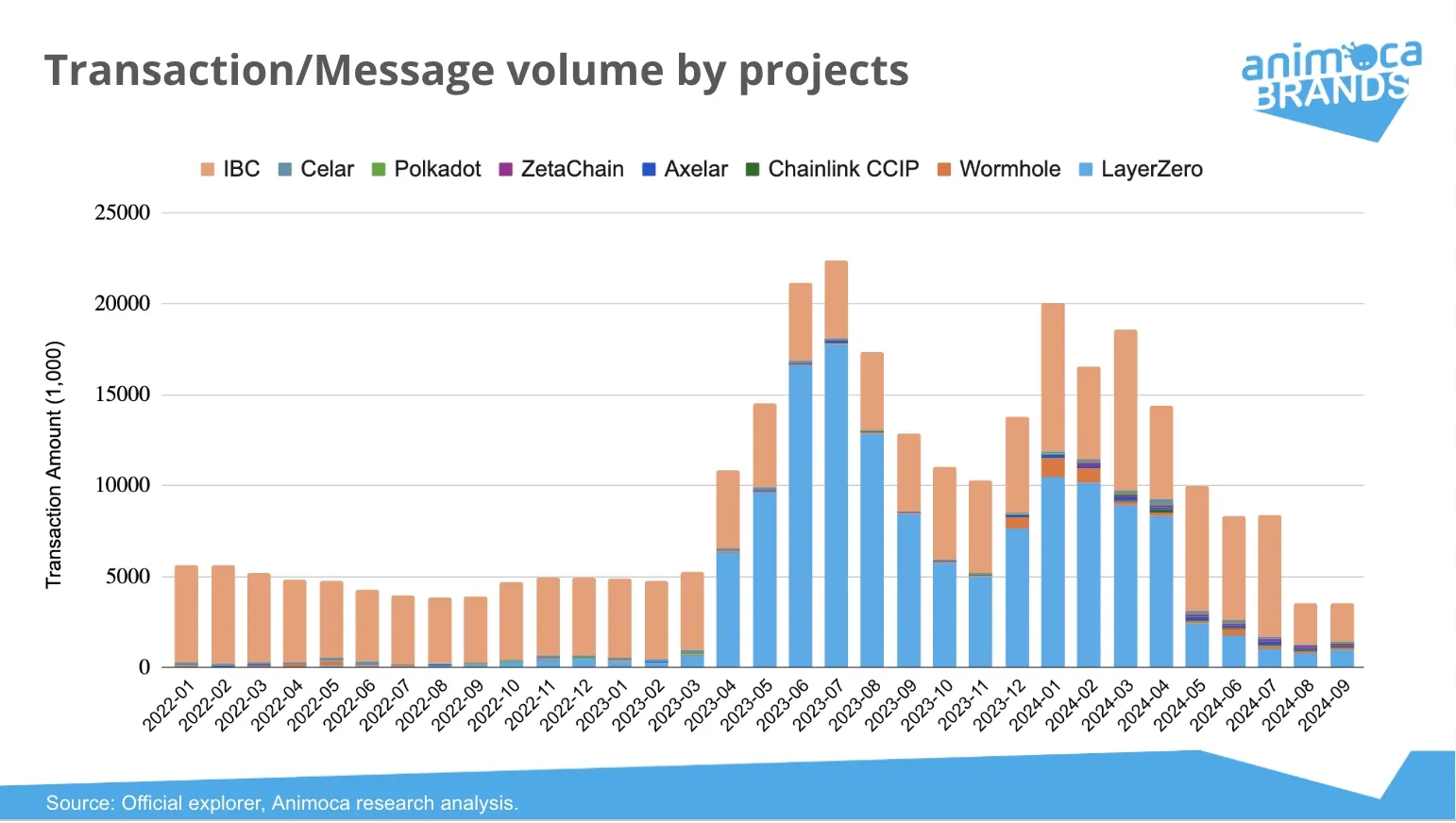
Source: Animoca Research on LayerZero Deep Dive Part2
*Hyperlane has been exlcuded, as the explorer provides limited data.
Projects developing on-chain products are the primary users of messaging protocols. In the following sections, we'll examine how LayerZero's infrastructure fulfills the needs of three distinct project groups:
Blockchain Projects: New L1s and L2s need to connect with other ecosystems, facilitating the movement of users and assets to their platforms.
Dapp Projects: Decentralized applications need to expand their reach across multiple chains to access liquidity and interact with other dapps.
Token Projects: Cross-chain functionality enables tokens to move freely between different blockchains, potentially increasing liquidity and utility.
To connect blockchains using LayerZero, two key components are required: (i) contracts deployed on each blockchain and (ii) Middleware Infrastructure—DVN and Executor—for message delivery and execution. Additionally, continuous monitoring is necessary to maintain a seamless connection after establishment.
In the very first step, the role of protocol administrators is crucial. A protocol administrator needs to deploy the LayerZero Endpoint on the new blockchain. This deployment connects the new chain to the LayerZero mesh network and enables the blockchain to send and recieve cross-chain messages.
This involves initiating and updating the network configuration to recognize and route messages to and from the new chain, and establishing appropriate parameters such as gas limits and fee structures for cross-chain transactions involving the new blockchain.
There are two main components that serve as the entry and exit point of the blockchain - Endpoint and MessageLib.
3.1.1 LayerZero Endpoint - A Single Immutable Deployment in Each Blockchain
The first and most crucial step in supporting a new blockchain is the deployment of a LayerZero Endpoint on that chain. The LayerZero Endpoint is an immutable, non-upgradeable smart contract that serves as the entry and exit point for the protocol on each supported blockchain.
While the core functionality remains consistent, the Endpoint contract may require customization to accommodate the specific features or limitations of the new blockchain. For example, tailoring the contract to optimize for the gas model of the new chain, ensuring cost-effective operations.
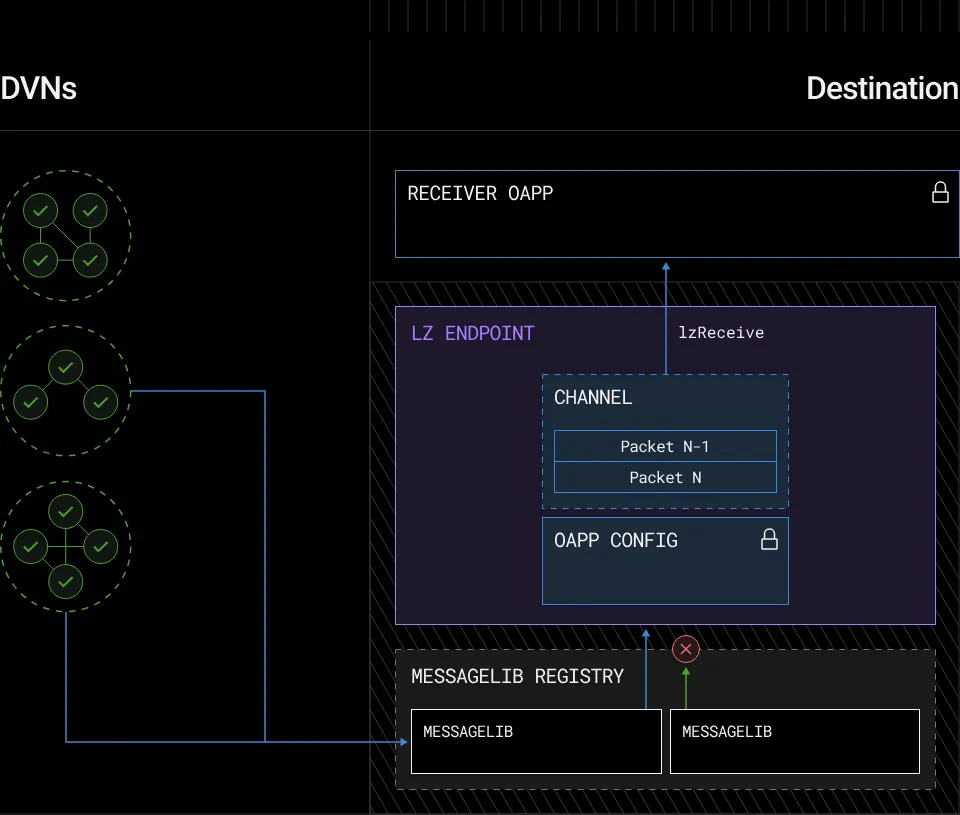
Source: LayerZero Endpoint | LayerZero
3.1.2 Implementation of MessageLib - Verifying Layer
After deploying the Endpoint, LayerZero implements the MessageLib, an immutable contract where Ultra Light Node 303 (ULN) is the most common one. The MessageLib encodes and processes messages based on the configured Security Stack, adapting to the new blockchain's data structures and consensus mechanisms. In some cases, LayerZero may develop a custom MessageLib to suit the blockchain's unique features.
The MessageLib has three main roles: Configuration Enforcement, Message Emission, and Verification. It accepts messages from the sender Endpoint, enforces Message Packet generation based on the OApp's configuration, determines which Security Stack and Executors the Endpoint emits to, and verifies packets on the destination chain before allowing commitment to the Endpoint's messaging channel.
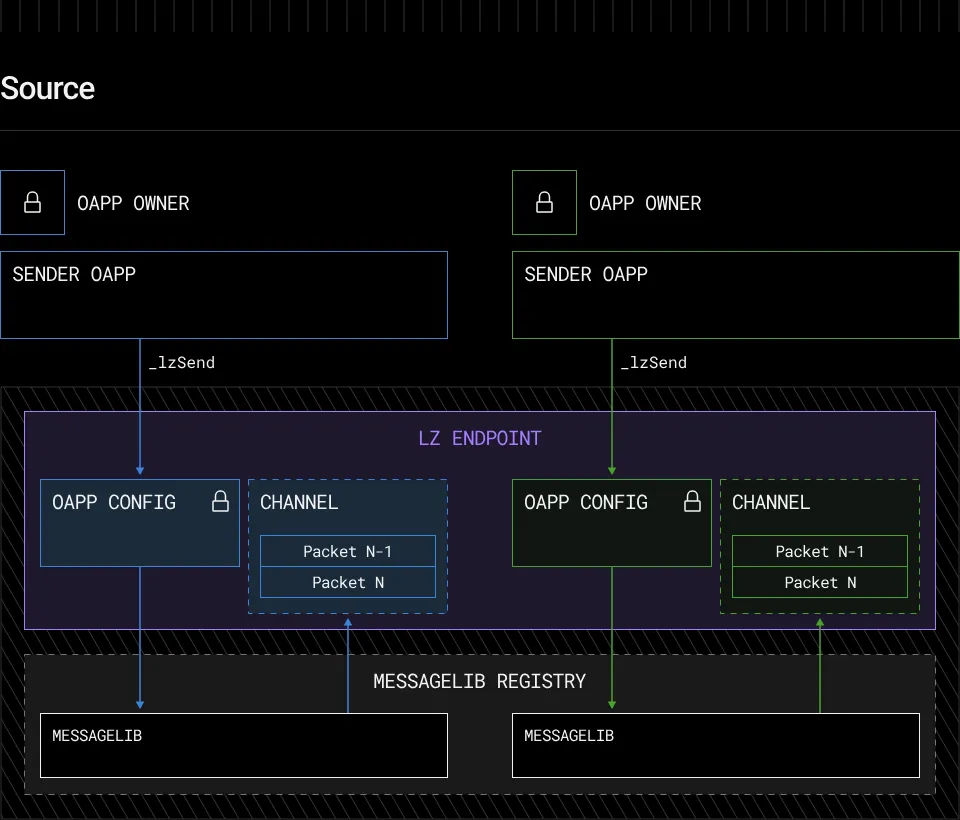
Source: Message Library | LayerZero
The middleware infra of LayerZero is responsible in the transportation and excution of the cross-chain messages. The two components, DVN is responsible for verifying and delivering the messages, and Executors executes the messages.
3.2.1 DVN - The Security Stack
The Security Stack of LayerZero is composed of DVNs of which applications can customize to verify cross-chain messages. This stack needs to be set up for the new blockchain to ensure secure message transmission, and there are currently 38 DVNs including Nethermind, Axelar, BitGo, Google Cloud, P2P, Polyhedera, etc.
This step involves either adapting existing DVNs to support the new blockchain's consensus proofs and data structures or developing new DVNs specifically designed for the unique aspects of the new chain.
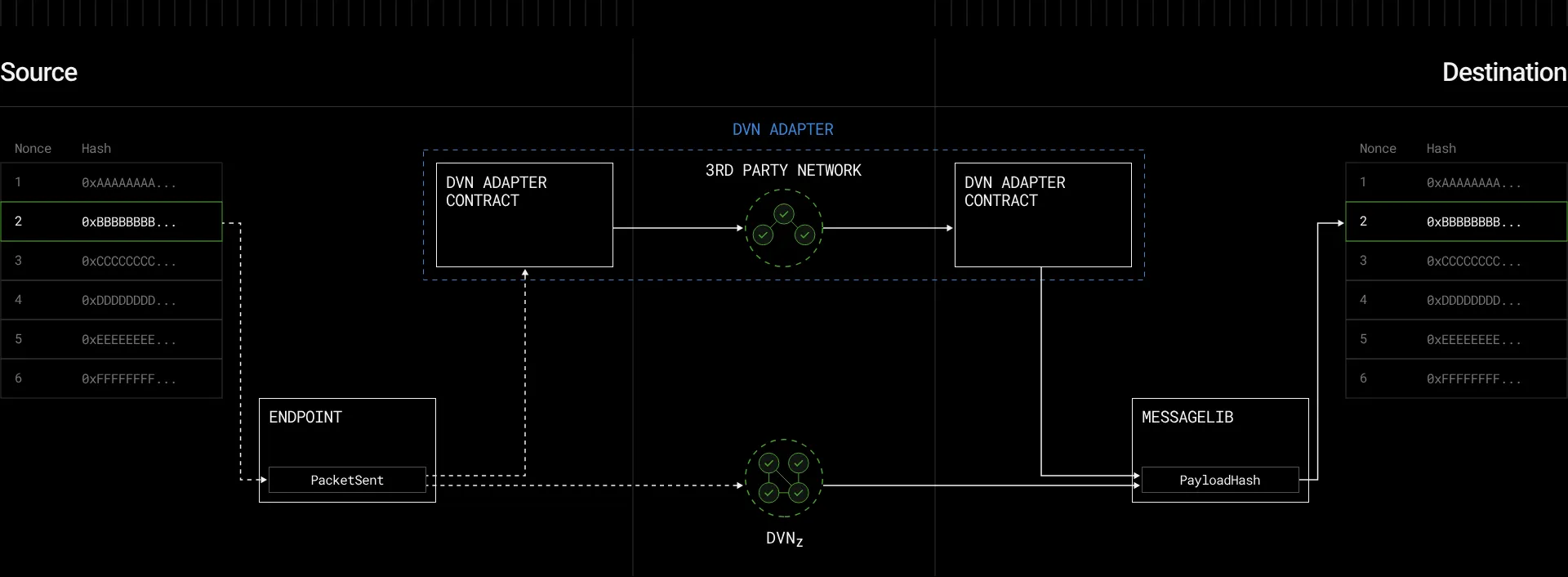
Source: Security Stack (DVNs) | LayerZero
3.2.2 Executors
Executors ensure message delivery on the destination chain by following the OApp owner's instructions for automatic omnichain message execution. This integration phase may involve deploying new nodes or upgrading existing ones. LayerZero may also need to set up or modify the executor reward system for the new blockchain, including rules for penalizing poor performance or malicious behavior. This approach helps maintain reliable service across the network. Also, projects can setup their Executor, as this can be deployed in a permissionless manner.
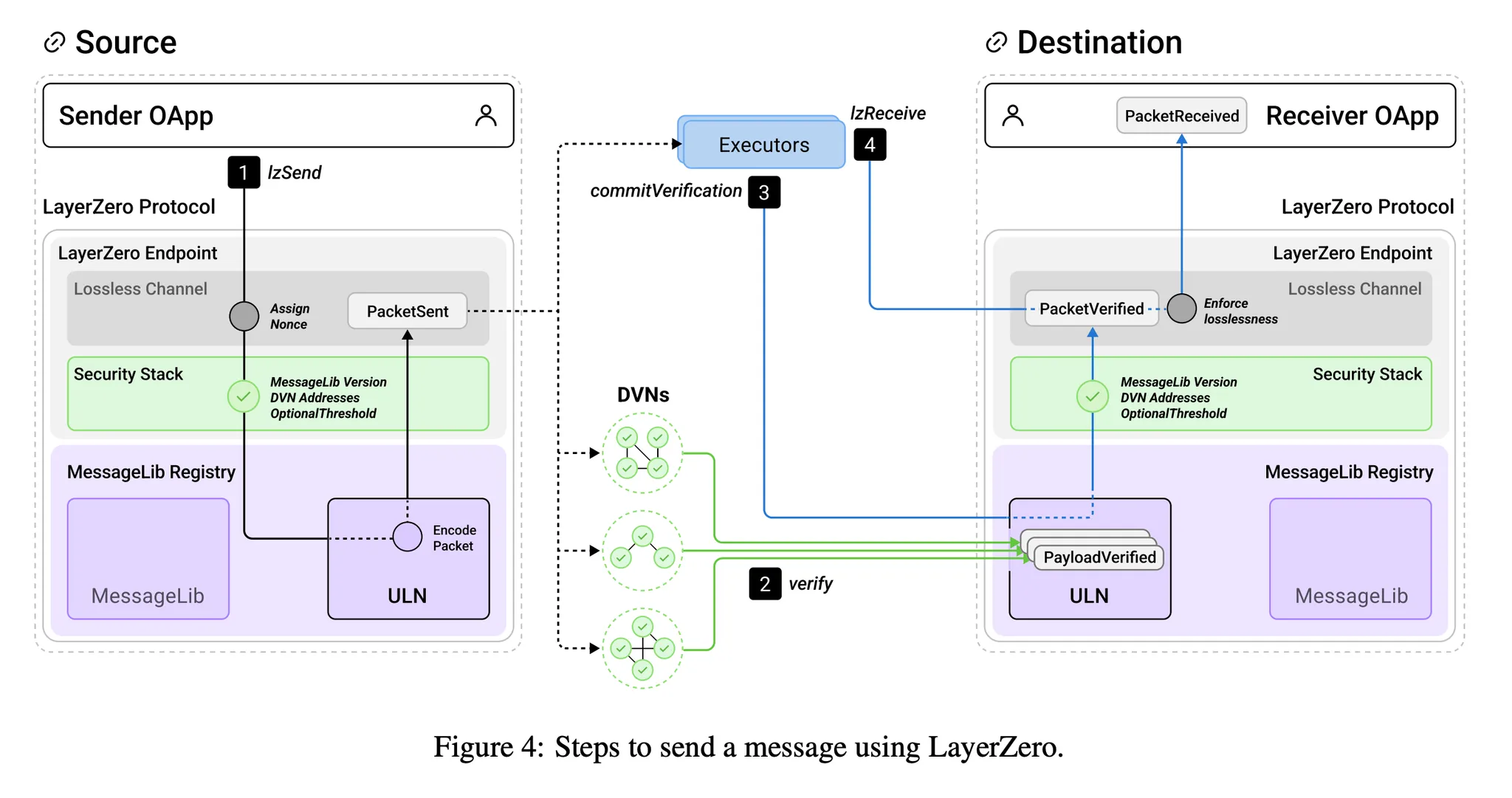
Source: LayerZero_Whitepaper_V2.1.0.pdf
Before full integration, extensive testing is conducted to ensure that all components work correctly with the new blockchain. This includes testing message sending, receiving, and execution across different scenarios. Also, continuous monitoring is necessary.
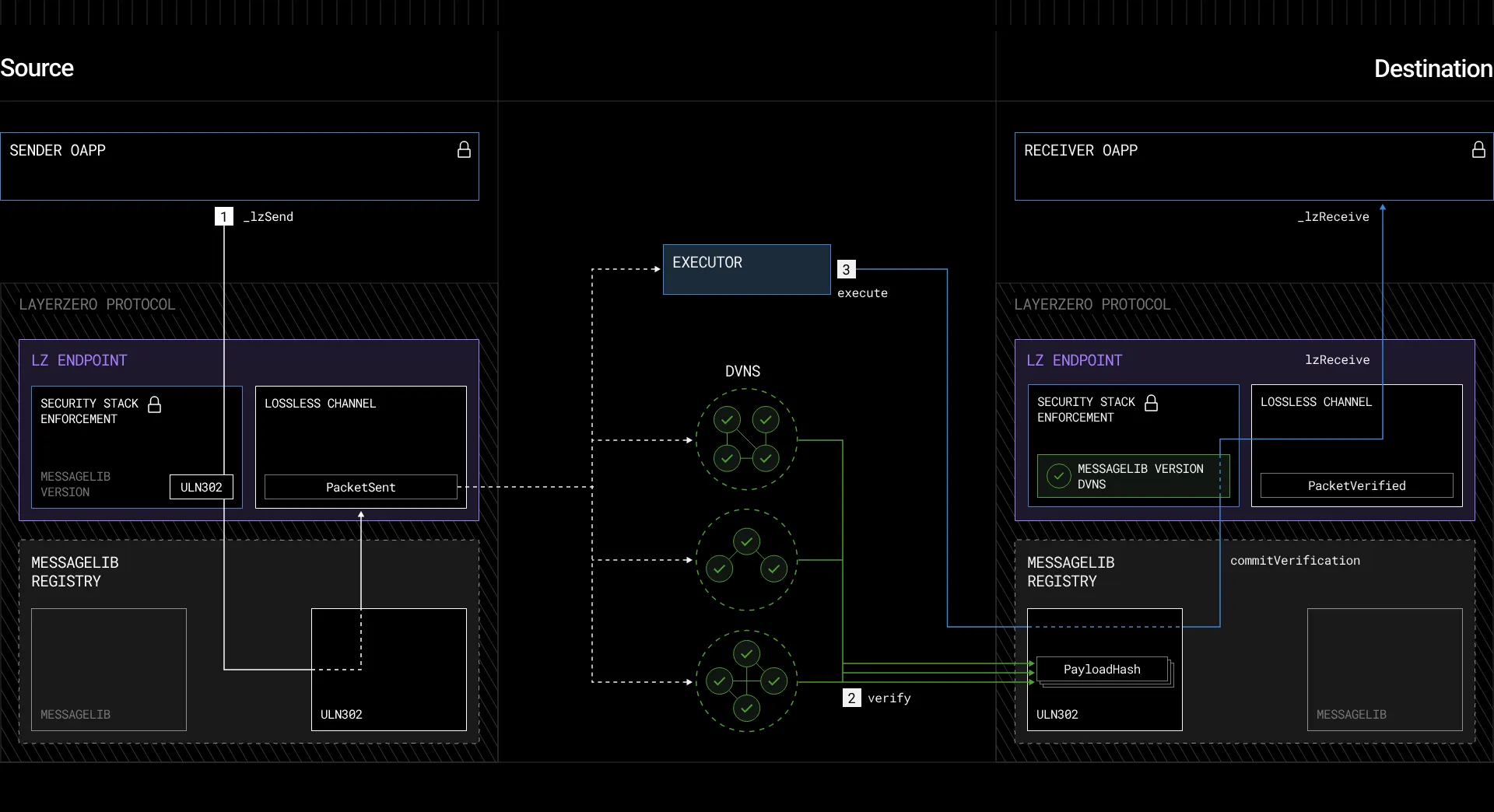
Source: Protocol Overview | LayerZero
LayerZero supports the most blockchains, currently 97 mainnet and 161 testnet, including EVM, MoveVM (e.g., Initia, Movement), and SVM (e.g., Solana). In the past three months, LayerZero announced support for various new blockchains, including:
L1: Initia, Sonic, Peaq, and Hedera
L2: Apechain, Unichain, Worldchain, Movement, Abstract, Ozean, BitLayer, LightLink
Among these announcements, three supports stand out:
Initia: LayerZero is planned to be implemented as a Cosmos module, embedding it in the L1 blockchain for interoperability with other ecosystems. L1 validators will be responsible for interoperability security, and combined with LayerZero's custom DVN, LayerZero infra can be configured to get aligned woth Initia's economics and security.
Movement and AltVM Support: There's a growing trend of support for alternative VMs—from EVM to MoveVM, and from Ethereum to the Cosmos ecosystem. With many AltVM projects set to launch soon, messaging protocols, including LayerZero, are increasingly prioritizing support for VMs beyond EVM. The recent support for Movement Testnet is a great case.
Apechain: This case is notable as LayerZero partnered with Arbitrum to make OFT as an omnichain token for the Arbitrum L2 and L3 ecosystem. (This will be explained in detail in section 4.3.)
The OApp standard provides a generic message-passing interface that enables contracts to send and recieve arbitrary data across different chains. An OApp contract inherits from both OAppSender and OAppReceiver, equipping it to handle outgoing and incoming cross-chain messages. When implementing the OApp standard, developers must define two essential functions: lzSend for sending messages and lzReceive for processing incoming messages.
This framework offers significant flexibility in creating cross-chain applications, allowing developers to implement custom logic for message handling based on their specific needs.
4.2.1 Aragon - Gasless Voting From Any Blockchain
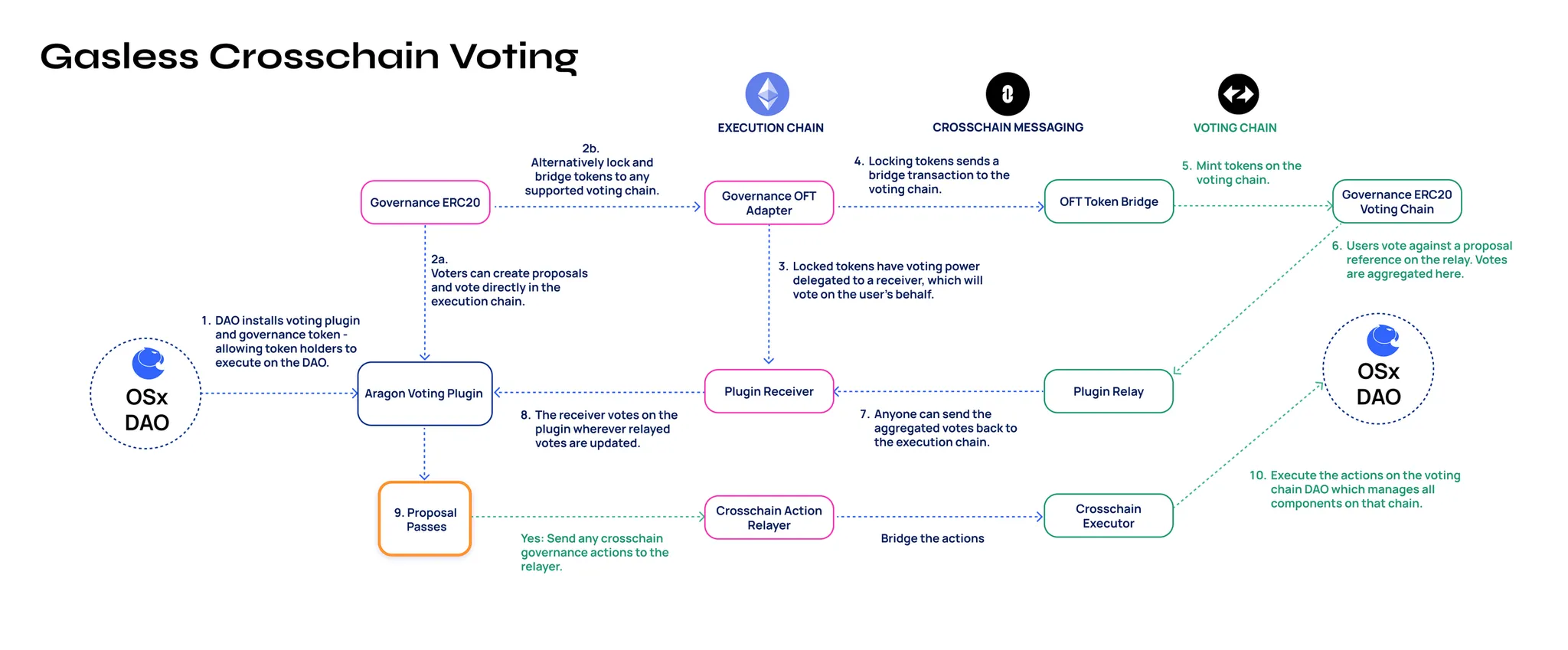
Source: Gasless Voting, Onchainhttps://github.com/aragon/toucan-voting-plugin
Gasless omnichain voting allows token holders to participate in DAO decision-making across multiple blockchain networks without paying gas fees. Aragon and LayerZero developed this solution, enabling DAOs to conduct secure, cost-effective voting on Ethereum mainnet while using cheaper chains for the actual voting process.
LayerZero is crucial in this system as the messaging protocol for cross-chain communication. It aggregates votes from execution chains back to the primary chain hosting the DAO's core smart contracts. The system uses LayerZero's OApp framework for voting across multiple blockchains. With custom OApps, it enables vote aggregation on a designated chain before relaying results to the home chain for final tallying. By integrating with solutions like zkSync's native account abstraction and Tsuko paymaster functionality, OApp allows users to cast votes without gas fees.
4.2.2 DeFi Kingdom - Custom Bridge
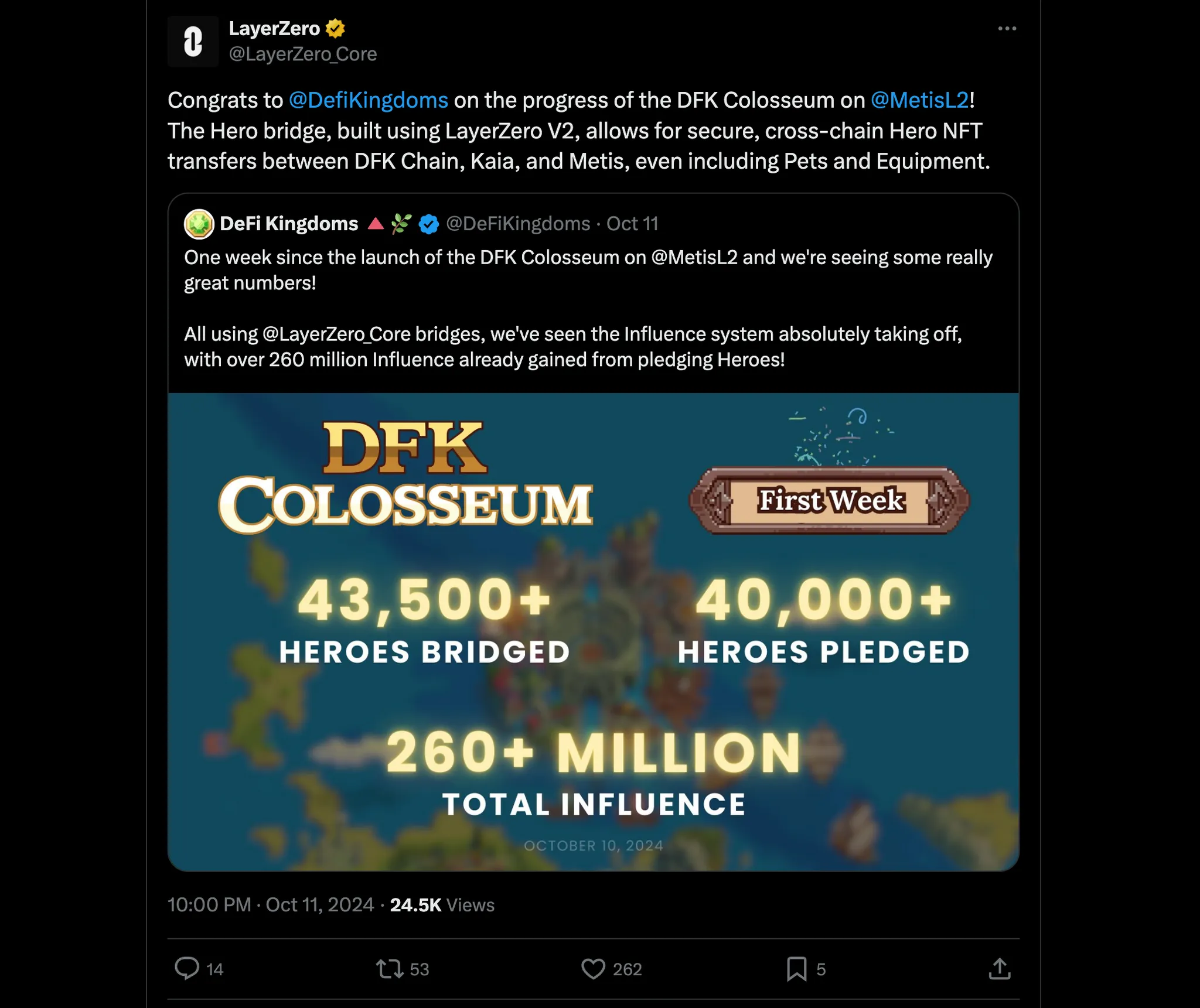
Source: X (@LayerZero_Core)
DeFi Kingdoms, a popular blockchain-based game, is leveraging the OApp standard. By implementing OApp, DeFi Kingdoms enables asset transfers between different blockchains. This integration allows players to interact with the game across various chains, expanding the game's reach and providing more flexibility in token usage and in-game activities.
The use of OApp in DeFi Kingdoms demonstrates the practical applications of LayerZero's technology in the gaming sector. It showcases how blockchain games can evolve beyond single-chain limitations, offering players a more interconnected gaming experience. The bridging is supported on blockchains like Avalanche C-Chain, DFK Chain, Klaytn, and Metis.
Token projects can benefit from expanding to other ecosystems for increased usage, such as trading and collateral assets for lending. However, token standards may vary across blockchains, making it challenging to control the total supply. LayerZero offers a solution by providing a standard for these token projects to expand across different chains.
Arjun from LiFi has conducted research on the current adoption of Token Frameworks. The findings show that OFT (Omnichain Fungible Token) has gained the most adoption. Also, LayerZero supports the widest range of blockchains.
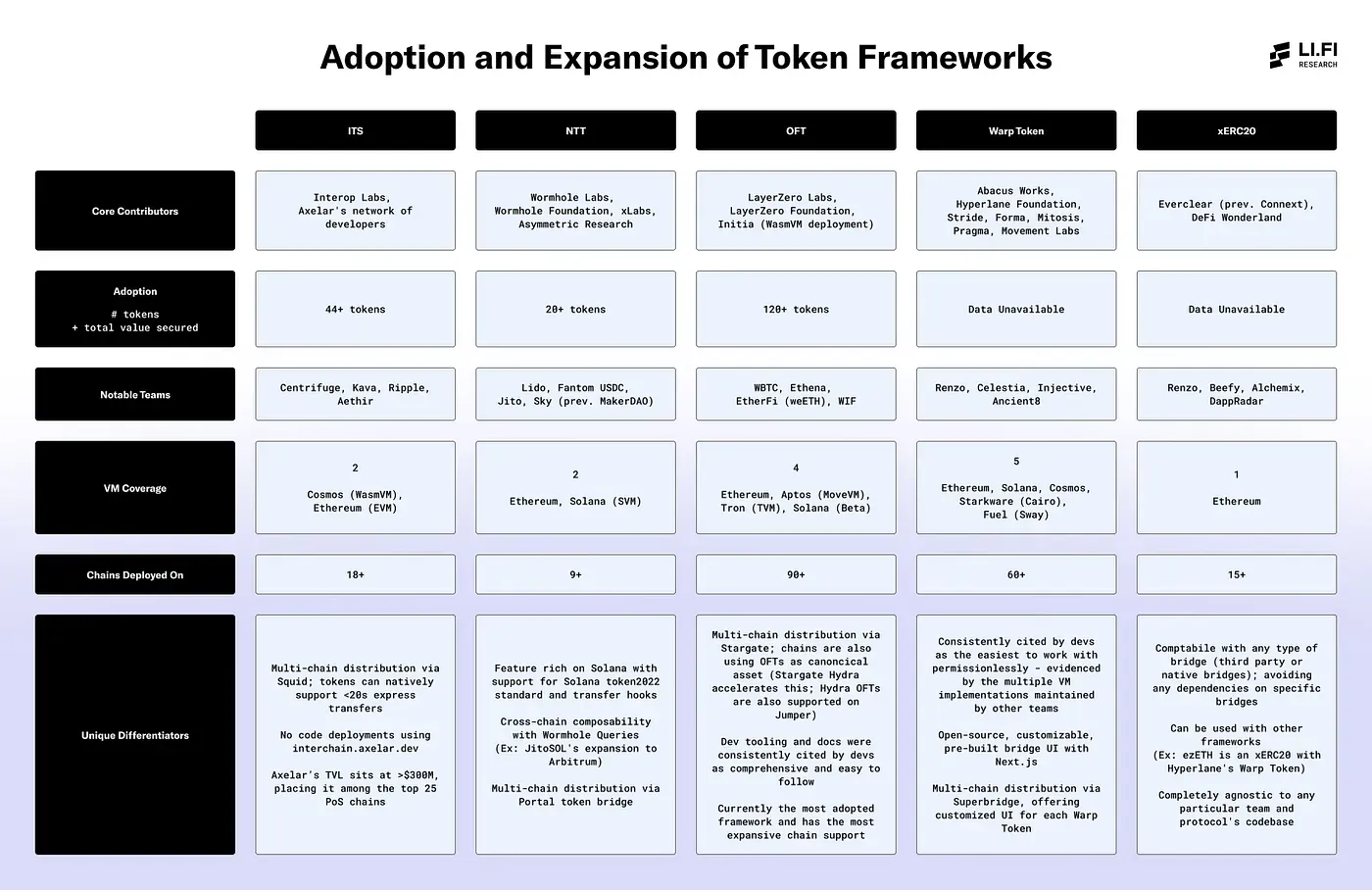
Source: Comparing Token Frameworks | by Arjun Chand | Sep, 2024 | LI.FI Blog
OFTs enable seamless transfer of fungible tokens across multiple blockchains without asset wrapping, middlechains, or liquidity pools. The LayerZero protocol facilitates this process, creating a unified token supply across supported networks. (A similar standard called ONFT supports Non-Fungible Tokens.)

Source: LayerZero V2 OFT Quickstart | LayerZero
LayerZero's Omnichain Fungible Token (OFT) standard has gained significant traction recently, with major projects adopting it for cross-chain interoperability. Two notable implementations are Wrapped Bitcoin (WBTC) and ApeChain’s APE. In the last two months, around 10 projects have onboarded OFT.
5.2.2 PYUSD - Omnichain Stabecoin by Paypal
Stablecoins are vital in crypto as they provide a stable pair for volatile crypto assets. However, developing different stablecoins for each blockchain is ineffective, as stablecoins require additional risk management and monitoring infrastructure to remain secure. This is where omnichain stablecoins can provide benefits. Stablecoins from one ecosystem can be sent to and used on other blockchains. With this strategy, USDT and USDC account for most of the stablecoin liquidity across multiple blockchains, supporting 82 and 80 blockchains respectively.
However, it is difficult to replicate the success of USDT and USDC as it requires a large team and infrastructure. Additionally, the number of blockchains is rapidly increasing, especially for L2s, with 89 L2s set to launch soon.
PayPal USD (PYUSD), a stablecoin by Paypal, now uses OFT Standard for transfers between Ethereum and Solana. Security is a key feature of this integration, with each PYUSD transfer secured by a group of DVNs chosen by PayPal USD and Paxos. The initial security stack includes Paxos, Google Cloud, and LayerZero Labs DVNs as verifiers.
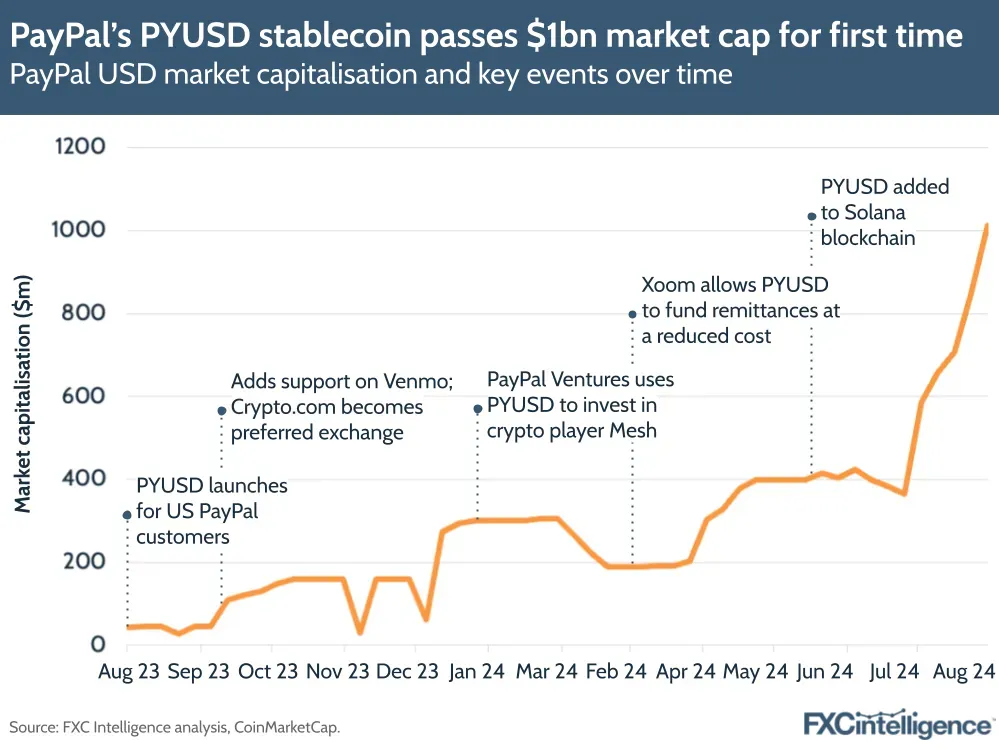
Source: What’s driving PayPal’s billion-dollar stablecoin?
5.2.2 WBTC - First Omnichain BTC
Wrapped Bitcoin (WBTC) has become the first omnichain BTC, with the integration of OFT standard. This development is particularly significant because BitGo, the issuer of WBTC, is participates as a DVN for $WBTC. By taking on this role, BitGo ensures that it maintains direct control and oversight over the security and verification of all cross-chain WBTC transfers.
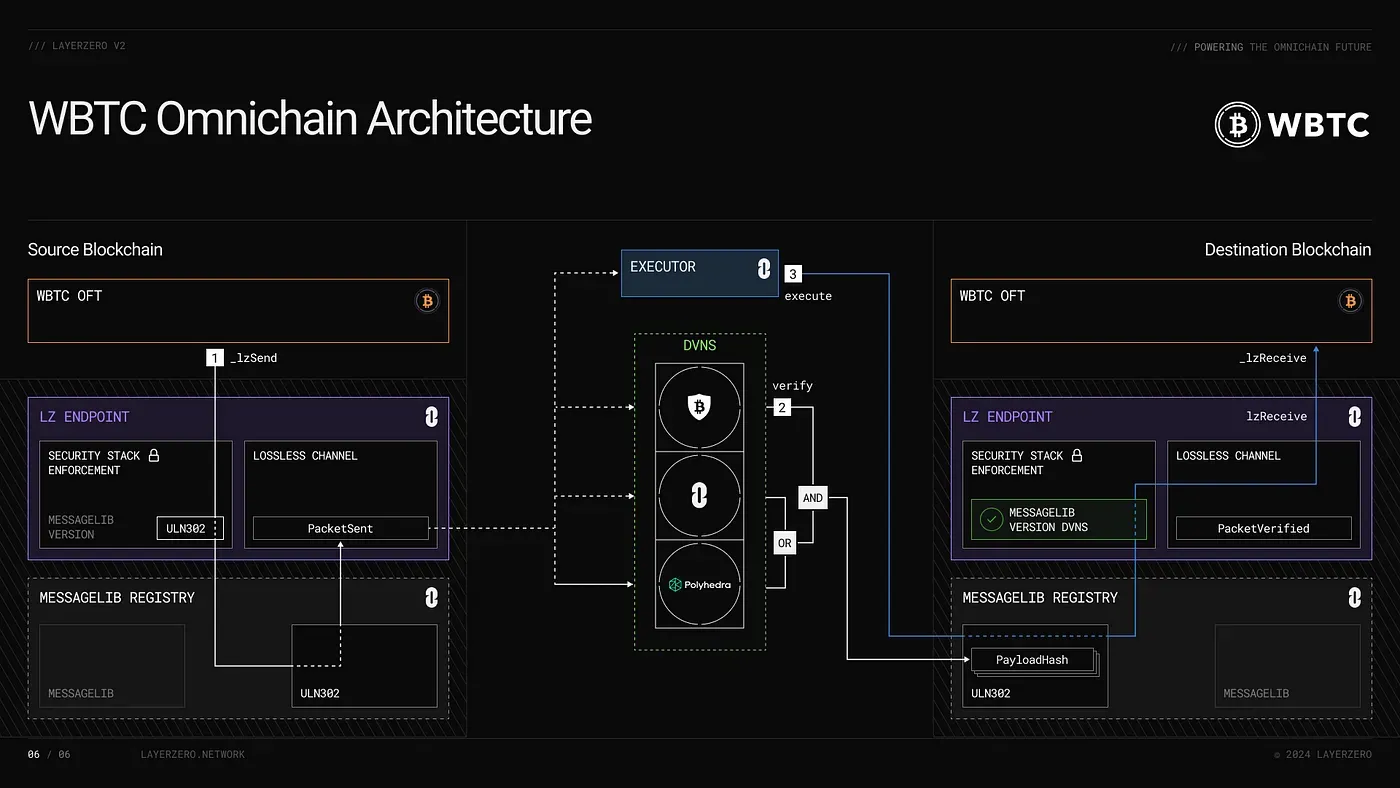
Source: LayerZero Selected as Official Interoperability Protocol by BitGo for WBTC | by LayerZero
5.2.2 APE, SANKO - Omnichain Token in Arbitrum Ecosystem
The implementation of APE as an OFT will enable seamless transfers across the Arbitrum Ecosystem. This is possible because LayerZero has also partnered with Arbitrum to deploy their infrastructure in Arbitrum Orbit. In a similar move, SANKO, another token in the Arbitrum ecosystem, has also announced its to become an OFT.
The unified liquidity approach, utilizing a shared "lockbox" contract, it enables users to move their OFTs between Arbitrum, Orbit chains, and over 90 other LayerZero-connected chains without encountering liquidity issues.

Source: LayerZero’s OFT Standard Natively Supported on Arbitrum Orbit | by LayerZero
Looking ahead, LayerZero demonstrates significant strengths in its approach to cross-chain messaging. One key advantage is its permissionless operation. The LayerZero Endpoint, an immutable smart contract, implements a standardized interface for OApps to manage security configurations for sending and receiving messages across blockchains. While initially deployed by the LayerZero team, this contract cannot be altered once in place. Then Dapps can configure their own security stack and verification methods for cross-chain messaging.
The permissionless nature of DVN and Executor deployments further enhances customizability. Dapps can choose to work with alternative middlemen if desired, all within a permissionless framework. This customization capability positions LayerZero to offer a wide range of options, from limited to extensive, in a trustless manner.
Another strength of LayerZero is its "Economic-Alignment" for projects. The customizable nature of the DVN enables "Infrastructure-Alignment" with protocols, as providers can be selected by individual projects. Additionally, the recent announcement of Restaking in LayerZero DVN introduces "Economic-Alignment." This means that in cross-chain messaging operations, revenue sharing and slashing can be tailored in the OApp configuration, providing further customization options for projects. (Check out this article to learn more about restaking in DVN)
Despite these strengths, LayerZero faces challenges from competitors While LayerZero holds the largest market share in messaging and supported blockchains, other messaging protocols like Axelar, Wormhole, and Hyperlane offer their own unique benefits.
A critical question for the future of cross-chain messaging is whether transaction volumes will increase. As the number of rollups and blockchains grows, cross-chain messaging is expected to become more prevalent. However, this growth is likely to be incremental rather than linear, influenced by factors such as interoperability needs and the evolving landscape of blockchain ecosystems.
Dive into 'Narratives' that will be important in the next year